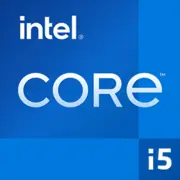Intel Core i5-1350P

Intel Core i5-1350P: 2025年のパフォーマンスとモビリティのバランス
2025年3月
現代のノートパソコンは、プロセッサーに速度だけでなくエネルギー効率も求めています。2023年に発表されたIntel Core i5-1350Pは、オールラウンドデバイスを必要とするユーザーにとって依然として有効なソリューションです。このチップが、なぜ今でもAMDやAppleの新製品と競争しているのか、そして2025年に誰に向いているのかを見ていきましょう。
アーキテクチャとプロセス: ハイブリッドコアと新しいレベルのグラフィックス
i5-1350PプロセッサーはRaptor Lake世代に属し、Intel 7プロセス(10 nm Enhanced SuperFin相当)で設計されています。その主な特徴は、高性能(P-core)とエネルギー効率(E-core)のコアの分離によるハイブリッドアーキテクチャです:
- 12コア:4 P-core(Golden Cove)でHyper-Threading(8スレッド) + 8 E-core(Gracemont)でマルチスレッドなし。
- ベースクロック:1.9 GHz(P-core)、1.4 GHz(E-core)。
- ターボブースト:P-coreで最大4.6 GHz、E-coreで3.5 GHz。
- キャッシュ:12 MB L3。
統合グラフィックスIris Xe(96 EU)は4Kディスプレイをサポートし、AV1エンコーディングを行い、CS:2やRocket Leagueなどのゲームで低設定で最大60 FPSを提供します。オフィス作業やFull HD動画編集には十分ですが、AAAゲームには専用グラフィックカードが必要です。
エネルギー消費とTDP: パワーマネジメント
プロセッサーのTDPは28Wで、ウルトラブックや薄型ビジネスノートパソコンでは一般的な値です。しかし、Turbo Boostモードでは一時的に64Wに達することがあります。これは高品質の冷却システムを必要とし、そうでなければスロットリングが発生する可能性があります。
省エネルギー技術:
- Intel Dynamic Tuning 3.0: 負荷に応じて自動的にパワーを調整します。
- コアの電圧低下(アンダーボルティング): ThrottleStopのようなユーティリティを介してサポートされています。
実際のところ、ブラウジングやWordを使用しているときにはプロセッサーが5-8Wを消費し、動画レンダリングの際には28Wに達します。
パフォーマンス: 見かけ以上の速さ
Geekbench 6:
- シングルコア: 2194(Ryzen 7 7840Uに相当)。
- マルチコア: 8684(Apple M2と同程度)。
実際のシナリオ:
- オフィス作業: Chromeで30以上のタブ、Excelシート、Zoomを同時に処理可能 - レイテンシなし。
- マルチメディア: HandBrakeでの1時間動画の変換に約12分を要する。
- ゲーミング: Genshin Impactを中設定(1080p)でプレイする場合、40-45 FPS。
Turbo Boostモードは、1-2コアに負荷がかかるときにアクティブになります(例えば、Photoshopで)。ただし、すべてのコアが負荷状態のとき(レンダリングなど)は、P-coreのクロックが熱のために2-3分後に3.8 GHzに低下します。
使用シナリオ: i5-1350Pは誰のために作られたのか?
- 学生とオフィスワーカー: マルチタスク + バッテリーライフ。
- フリーランサー: 軽い動画編集、FigmaやBlenderでの作業(中程度の難易度のプロジェクト)。
- 旅行者: 重量1.5kg以下の薄型ノートパソコン(例えば、Dell XPS 13やLenovo Yoga Slim 7)。
向かない:
- Cyberpunk 2077で100 FPS以上を求めるゲーマー。
- SolidWorksで3Dモデルを扱うエンジニア。
バッテリーライフ: バッテリーはどのくらい持つか?
バッテリー容量60Whの場合:
- ウェブブラウジング: 8-10時間。
- 4K動画再生: 6-7時間。
- 負荷(Photoshop + Chrome): 3-4時間。
エネルギー効率:
- BIOS設定でE-coreをオフにする(動作時間が15%増えるが、マルチスレッド性能が低下する)。
- Windows 12の「省エネルギーモード」: クロックを2.5 GHzに制限。
競合との比較: i5-1350Pは誰を追い越すのか?
- AMD Ryzen 5 7640U(Zen 4): マルチスレッドタスクで優れています(Cinebench R23で+10%)が、シングルスレッドでは劣っています(-7%)。ノートパソコンの価格は同程度($900-$1100)。
- Apple M2: バッテリーライフが優れており(最大12時間)、ネイティブアプリ(Final Cut Pro)での速度も速いが、Windowsソフトとの互換性には制限があります。
- Intel Core i5-1250P(Alder Lake): i5-1350Pは最適化されたE-coreによりマルチタスク性能で12%速い。
長所と短所
強み:
- オフィスワークと勉強に最適。
- Thunderbolt 4およびWi-Fi 6Eをサポート。
- ノートパソコンの価格は手頃($800から)。
弱点:
- 負荷時のファンの騒音。
- Turboモードでの温度が95°Cに達する。
- PCIe 5.0のサポートがない。
ノートパソコン選びの推奨事項
1. デバイスタイプ: ウルトラブック(ASUS ZenBook 14)またはビジネスノートパソコン(HP EliteBook 840 G10)。
2. 冷却: 2つのファンと銅管を使用したモデルを探す(例えば、Lenovo ThinkPad T14s)。
3. ディスプレイ: 300ニットおよびsRGB 100%のIPSパネル(デザイナーには重要)。
4. バッテリー: 最低60Wh。
5. メモリとSSD: 16GB DDR5 + 512GB NVMe(アップグレードは早めに行う — 多くのウルトラブックにはRAMスロットがない)。
2025年におけるi5-1350P搭載ノートパソコンの平均価格: $850–$1200。
総括
Intel Core i5-1350Pは、パフォーマンス、ポータビリティ、価格のバランスを求める人にとって成功した選択肢です。日常的なタスク、軽いクリエイティブ作業、さらには要求の少ないゲームにも対応できます。しかし、3D作業やストリーミングを専門的に行う場合は、Hシリーズプロセッサー(例えば、i7-13700H)やRyzen 7 7840HSを搭載したモデルを検討する方が良いでしょう。
向いている人:
- 学生。
- オフィスワーカー。
- デザインや編集のフリーランサー。
- 静音性と長いバッテリーライフを重視するユーザー。
予算が$1000以内であれば、i5-1350Pは2025年のベストな選択肢の一つです。
基本
CPUの仕様
メモリ仕様
GPUの仕様
その他
ベンチマーク
他のCPUとの比較
ソーシャルメディアで共有する
または当サイトへのリンクを追加
<a href="https://cputronic.com/ja/cpu/intel-core-i5-1350p" target="_blank">Intel Core i5-1350P</a>